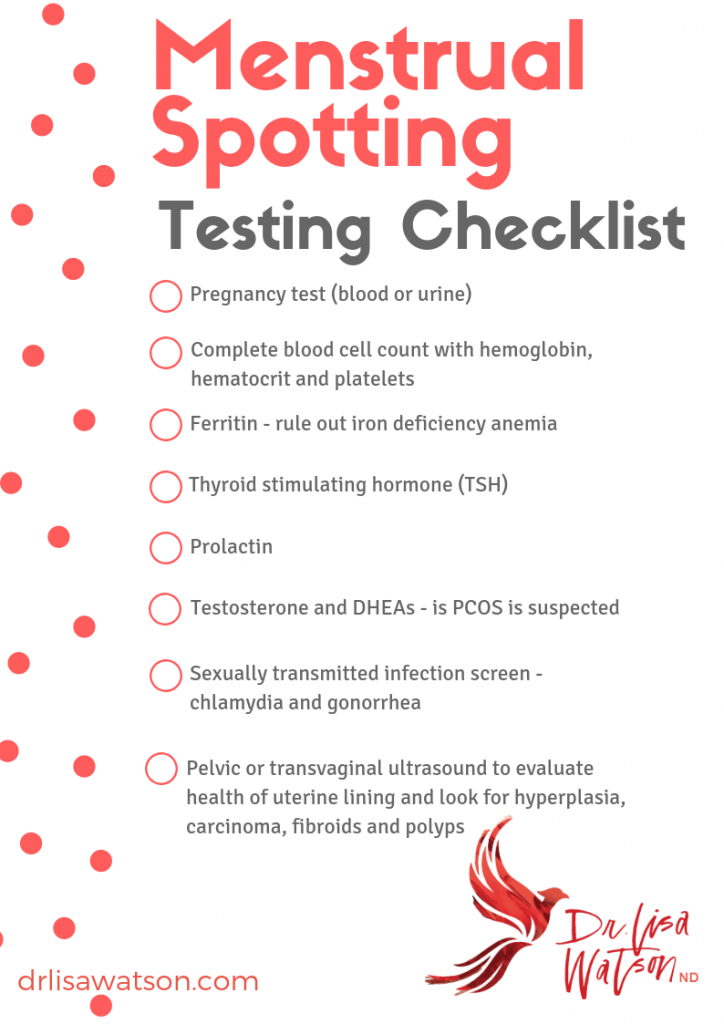
“Why am I spotting?” is a common question that comes up in my naturopathic practice, impacting up to 1 in 3 women at some point in their reproductive lifespan. Spotting is most common in women during adolescence and during the transition to menopause, but can occur at any point in a woman’s life. While most women are told spotting is not significant, speaking to your doctor is suggested to determine the underlying cause.
What is Spotting
Spotting, also called intermenstrual bleeding, or even more technically “metrorrhagia” occurs when there is bleeding from the uterus at irregular intervals, most often between expected menstrual periods.
Causes of Spotting
-
Ovulation
Ovulation is the most common cause of spotting in women. Around ovulation estrogen levels drop off slightly as an egg is released from the ovary. This drop in estrogen can lead to bleeding that is most often significantly lighter than a period and lasts for a shorter time. The blood may also be a different colour – brownish or pink. This ovulatory spotting is considered to be normal, but you should discuss with your health care provider to ensure nothing else is causing this symptom.
-
Birth control pill
 Birth control pills, and other forms of hormonal contraception (IUDs, patches, injections and implants), commonly cause spotting (called “breakthrough bleeding”) during the first few months of use. Most common in the first three months, for some women it doesn’t improve – if this happens a higher dose birth control or different method of contraception may be needed. Breakthrough bleeding is also common if you don’t take your pills as directed (missing a day or not taking at the same time each day). Women who smoke and take birth control pills are more likely to experience breakthrough bleeding (and should consider other forms of contraception due to the increased risk of blood clots.)
Birth control pills, and other forms of hormonal contraception (IUDs, patches, injections and implants), commonly cause spotting (called “breakthrough bleeding”) during the first few months of use. Most common in the first three months, for some women it doesn’t improve – if this happens a higher dose birth control or different method of contraception may be needed. Breakthrough bleeding is also common if you don’t take your pills as directed (missing a day or not taking at the same time each day). Women who smoke and take birth control pills are more likely to experience breakthrough bleeding (and should consider other forms of contraception due to the increased risk of blood clots.)
Other medications have also been found to be associated with intermenstrual bleeding, including anticoagulants (warfarin, heparin), antipsychotics, corticosteroids, and selective serotonin reuptake inhibitors (SSRIs.)
-
Polycystic ovarian syndrome
One of the hallmarks of PCOS is irregular periods. In PCOS women do not ovulate, which leads to a lack of progesterone production and unopposed estrogen causes continued growth of the uterine lining. The lining will continue to thicken until it outgrows its blood supply and degenerates. Different sections of the lining may outgrow their blood supply at different times, causing spotting.
This lack of ovulation can also have similar results in adolescent girls who do not yet have a mature reproductive hormone cascade, resulting in spotting.
-
Local infections
Infections of the vagina, cervix and endometrial lining can all cause spotting between periods. The infection is most often secondary to a sexually transmitted infection, but can also occur with pelvic inflammatory disease. Inflammation of the cervix (cervicitis) or uterine lining (endometritis) can also cause bleeding after sexual intercourse.
-
Uterine or Cervical Polyps
Polyps are soft growths that can occur on the inside surface of the uterus or on the surface of the cervix. These growths are benign but may cause irregular bleeding, especially after intercourse.
-
Perimenopause
 The changes in hormone balance that occur in the years prior to menopause can lead to irregular periods and spotting between periods. With the transition to menopause comes a decrease in egg quality, resulting in less progesterone production and shorter menstrual cycles. The decline in successful ovulation can also lead to longer cycles. And both of these states of hormonal imbalance can lead to spotting.
The changes in hormone balance that occur in the years prior to menopause can lead to irregular periods and spotting between periods. With the transition to menopause comes a decrease in egg quality, resulting in less progesterone production and shorter menstrual cycles. The decline in successful ovulation can also lead to longer cycles. And both of these states of hormonal imbalance can lead to spotting.
-
Thyroid hormone imbalances
The healthy function of the thyroid directly influences the healthy function of the reproductive organs. Under functioning of the thyroid (hypothyroidism) has been known to cause menstrual spotting, and correcting the underlying imbalance typically resolves the symptom.
-
Pregnancy
Spotting in pregnancy can be an alarming symptom, but for many women it is totally normal. Some women experience spotting associated with implantation that can be very similar to a menstrual period. If you do experience spotting in pregnancy, see a doctor immediately to ensure optimal safety for both mom and baby, and to rule out an ectopic pregnancy which can be life-threatening if not treated.
-
Uncommon causes
Less common causes for intermenstrual spotting include foreign bodies in the vagina (most often toilet paper or tampons) and certain types of reproductive cancers, including cervical, ovarian, endometrial and vulvar cancers. Clotting disorders can also worsen spotting and should be considered in teen girls with heavy periods or frequent spotting.
Testing for Spotting
While most spotting between menstrual cycles is benign and normal, it is important to try to identify an underlying cause, and correct it if possible. Achieving hormone harmony is possible, and can be done with the support of your Naturopathic Doctor.
Discuss this checklist with your Medical or Naturopathic Doctor to help you achieve your personal hormone balance.
Disclaimer
The advice provided in this article is for informational purposes only. It is meant to augment and not replace consultation with a licensed health care provider. Consultation with a Naturopathic Doctor or other primary care provider is recommended for anyone suffering from a health problem.

















